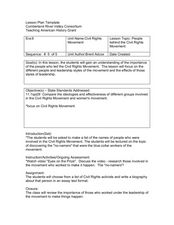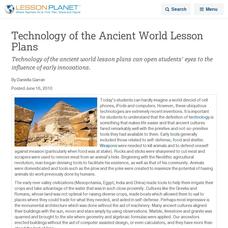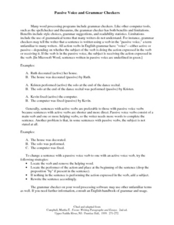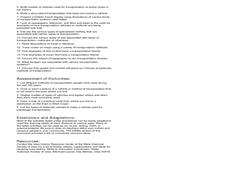Curated OER
Measurement of Biotic and Abiotic Objects
Students identify biotic and abiotic factors. In this environmental study lesson plan, students conduct a series of experiments to collect and record data and draw conclusions based on the results.
Curated OER
Models as Tools for Ecosystem Management
Fifth graders explore the concept of environmental management. In this ecosystem instructional activity, 5th graders discover how models help scientists learn more about managing ecosystems. Students create their own model, make...
Curated OER
Oceans: A Sensory Haiku
Young scholars create an ocean haiku. For this haiku lesson, students use their five senses to write a haiku. Young scholars watch videos about the ocean, make a sensory portrait, and create a class haiku.
Curated OER
The Mayflower Compact
Fourth graders explore the events leading up to the Mayflower Compact. In this government lesson, 4th graders have a teacher-led class discussion on the importance of government, then complete a worksheet on the topic.
Curated OER
People behind the Civil Rights Movement
Students identify the people actively involved in the Civil Rights Movement. In this United States History lesson, students watch the video "Eyes on the Prize" then participate in a class discussion about the video. Students also...
Curated OER
Introduction to Restoration Lesson
Students explore how pollution and invasive plants disrupt the ecosystem. In this restoration lesson plan students list materials that pollute wetlands, how people can keep them clean and ways in which invasive plants establish.
Curated OER
Too Cool for School-The Greenhouse Experiment
Students create a town model and analyze the type of greenhouse gases their town emits. In this earth science lesson, students build greenhouses to investigate how trapped heat causes temperature change. They relate this activity to...
Curated OER
Technology of the Ancient World Lesson Plans
Technology of the ancient world lesson plans can open students' eyes to the influence of early innovations.
Curated OER
Passive Voice and Grammar Checkers
This handout gives an overview of the passive and active voices as well as pointing out that the grammar checkers in word processing programs mark sentences written in the passive voice as incorrect. While this is not an interactive...
Curated OER
Major American Water Routes
Sixth graders locate and identify the major bodies of water and waterways in the United States. Through a simulation activity, they describe how early explorers would have described their surroundings. Working in groups, they create...
Curated OER
Fish Haunts
Students examine some of the different ecosystems that fish live in. While doing this they identify the species of fish and the ecological conditions needed for survival. Students use research resources to make fish cards that have...
Curated OER
Putting It All Together: Creating an artifact
Eleventh graders analyze a variety of images and documents, then create artifacts to archive, such as a newspaper, an album, or scrapbook from their writings, drawings, and projects. They present learned information to their peers
Curated OER
Float the Boat
Students collect data and analyze it using a graph. In this algebra lesson, students identify different bodies of water and relate the flowing to math. They collect data on the rate of flow and the height of flow. They analyze the data...
Curated OER
Canada, Our Neighbor to the North
Students obtain knowledge of Canadian geography and history. Students work in groups gathering information to create a brochure on Canada. Students discover how French and British history helped shape Canada as a nation.
Curated OER
Exploring the Illinois and Michigan Canal
Seventh graders locate the Illinois & Michigan Canal and related landmarks on various maps. They explain the challenges associated with building a canal. They access websites imbedded in this plan and watch a video to aid their...
Alabama Learning Exchange
Forces that Change the Land
Learners conduct Internet research find information about the following landforms: mountains, canyons, and valleys. They create travel brochures of their findings.
Curated OER
Getting from Place to Place
Learners examine modes of transportation. In this transportation lesson plan, students listen to their instructor present a lecture on modes of transportation over the past 300 years. Learners respond to questions...
Curated OER
For the Last 10,000 Years...
High schoolers study the National Estuarine Research Reserve System and discuss why they have important cultural artifacts. In this estuarine weather lesson students use the Internet and complete a worksheet.
Curated OER
Walking on Frozen Ground
Learners listen to an Elder speak about permafrost structures in their area. In this permafrost lesson plan, students listen to the guest speaker, take a tour outside to view permafrost structures, and draw them.
Curated OER
Earth's Land and Water
Young scholars describe physical characteristics of bodies of water and landforms. In this land and water lesson plan, students model land and water with modeling clay and also discuss why people live near bodies of water.
Curated OER
Erosion in Freshwater Ecosystems
Students explore the concept of sediment pollution. In this erosion lesson, students discuss the process of erosion and determine how sediment pollution affects animals that live in freshwater ecosystems. Students respond to questions...
Curated OER
Adventures of Lewis and Clark Lewis and Clark Journal
Eighth graders experience the Lewis and Clark expedition. In this Corps of Discovery instructional activity, 8th graders research details regarding the expedition in order to complete a classroom project that requires them to create...
Curated OER
The Challenges Ahead
Students examine the physical obstacles that the Lewis and Clark expedition encountered on its journey. They report what challenges these physical obstacles might have posed. They review a modern-day map and explain if the obstacles...
Curated OER
Wacky Water Critters
Students visit a local creek or stream. They collect water samples from the creek and observe and sort the "water critters" they find in the sample, observing smaller organisms under a microscope if necessary. They identify each organism...

























